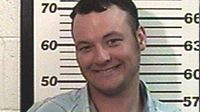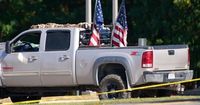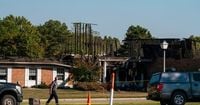On a quiet Sunday morning in Grand Blanc Township, Michigan, tragedy struck a local congregation of the Church of Jesus Christ of Latter-day Saints. What began as a typical worship service on September 28, 2025, ended in horror when Thomas Jacob Sanford, a 40-year-old former Marine, crashed his Chevy Silverado into the church’s brick wall, opened fire on churchgoers, and set the building ablaze. The attack left four people dead and at least eight others wounded, ranging in age from six to seventy-eight, sending shockwaves through the community and raising difficult questions about hatred, mental health, and the roots of violence.
Sanford’s rampage was not a random act. According to The Associated Press and The New York Times, friends and acquaintances described a long-simmering animosity toward the Mormon faith that dated back more than a decade. His hatred, they said, emerged after a failed relationship with a devout member of the LDS Church during his time living in Utah. “He got this whole fascination with Mormons, and they are the Antichrist, and they are going to take over the world,” Francis Tersigni, a lifelong friend, told The New York Times. Sanford’s obsession with the church was so pronounced that he would bring it up at social gatherings, even at his best friend’s wedding. “All he could talk about was Mormons,” Francis added. “I was like, dude, nobody wants to hear about this stuff.”
Sanford’s transformation was marked by a series of personal struggles. After serving four years in the Marine Corps and deploying to Iraq—a period described by his commander as “a relatively quiet time” without direct combat—Sanford moved to Utah. There, he fell in love with a woman deeply committed to the LDS Church. His landlord, Sandra Winter, recalled that Sanford felt pressure to convert, but ultimately remained unsure. “He wasn’t so sure that he wanted to become a member of the church,” Winter said. “But he really wanted to be with this woman.” The relationship ended, leaving Sanford deeply hurt and, as friends noted, a changed man. Substance abuse followed; Sanford developed a methamphetamine addiction, and his once jovial demeanor faded. “Mentally [Sanford] was in rough shape,” Peter Tersigni, another close friend, told The New York Times.
Sanford’s troubles in Utah weren’t limited to personal relationships. Court records obtained by KUTV show that on March 12, 2010, Sanford was arrested in Summit County, Utah, for DUI, with a blood alcohol level of .18—over twice the legal limit at the time. The charge was later amended to impaired driving, and Sanford pled guilty, receiving a suspended jail sentence, a $750 fine, probation, mandatory treatment, and community service. The case linked him to a Michigan address, hinting at his eventual return home.
Back in Michigan, Sanford’s bitterness toward the Mormon faith only deepened. Friends said he would often launch into rants about the church around bonfires or at gatherings, insisting that Mormons were “going to take over.” Yet, as Francis Tersigni noted, “There’s a Jake we all knew, and there was one who was hidden. It wasn’t apparent to us.” Sanford’s outward life seemed stable—he was married, raising a child, and enjoyed hunting. But beneath the surface, old grudges festered.
Just six days before the attack, Sanford’s animosity surfaced again in a conversation with Kris Johns, a local city council candidate. Johns, who met Sanford while canvassing neighborhoods, recalled, “Within a few minutes, Sanford was telling him about how ‘Mormons are the Antichrist.’ That’s something I’ll never forget.” Sanford’s fixation on the LDS Church was as intense as ever, and, as it turned out, a harbinger of the violence to come.
The events of September 28 unfolded with terrifying speed. Police received a call at 10:25 a.m. that a shooting was underway at the church. Within 30 seconds, officers from Grand Blanc Township and the state’s Department of Natural Resources arrived, engaging Sanford in a gunfight outside the burning building. He was shot and killed by law enforcement at the scene. According to The Independent, Sanford had also brought explosive devices, and used gasoline to ignite the fire that ultimately reduced the church to rubble. Flames and smoke poured from the structure for hours, and the devastation was total.
The victims of the attack included John Bond, a Navy veteran and beloved grandfather who was known for his love of golf and trains, and Pat Howard, 77, who attended the service with his wife Kitty. The wounded, whose ages spanned from a young child to elderly parishioners, are expected to survive. In the chaos, neighbor Jerry Eaton, 78, opened his door to shelter seven people fleeing the violence—among them a mother and her four young children. “I’ve done a lot of hunting, so I know the sound of gunfire,” Eaton told The Associated Press. “As much as I didn’t want to believe it, that’s exactly what it sounded like.”
In the aftermath, the community has rallied together, drawing strength from across faith traditions. Jeffrey Schaub, bishop of the Grand Blanc church, described the congregation as “quite shaken in spirit and in body,” but also deeply moved by the outpouring of support. “It was very humbling to see how much good there is in the world today and that, above all, we are all children of the same Father in heaven,” he said, his voice trembling with emotion.
The FBI continues to investigate the shooting as a “targeted act of violence.” White House Press Secretary Karoline Leavitt confirmed that Sanford “hated people of the Mormon faith.” Although Sanford was reportedly a supporter of former President Donald Trump—his yard displayed a Trump sign, and he was seen wearing conservative attire—investigators have found no evidence that the attack was politically motivated. “This isn’t a MAGA event,” Francis Tersigni insisted. “It isn’t political.”
Sanford’s family, through a lawyer, expressed their sorrow in a statement: “No words can adequately convey our sorrow for the victims and their families.” The pain, confusion, and grief are palpable in Grand Blanc Township, but so too is resilience. As the church’s charred remains are cleared and families mourn, the community faces the difficult work of healing and reflection, determined to honor the memory of those lost and support those whose lives have been forever changed.


